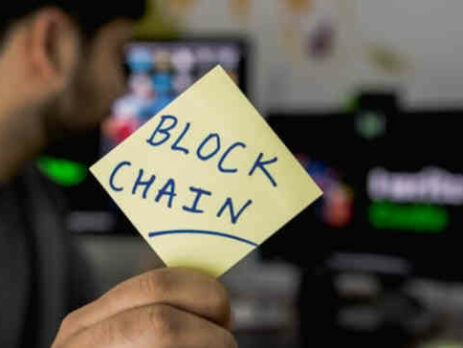The Creative’s Guide to Blockchain
Although it was first described as early as 1991, blockchain wasn’t implemented until the cryptocurrency bitcoin was launched in 2009. The goal of bitcoin is to record and distribute information securely across a computer network, or ‘chain’. Once information is added to the chain, it is very difficult to edit.
Blockchain is most famous today for its use in cryptocurrencies and financial transactions. It has huge potential as a disruptive force as a P2P payment resource that doesn’t require a financial institution as an intermediary. There are also many opportunities for blockchain technologies in creative industries.
Voting, NFTs, advertising, and royalties are just some of the areas ripe for creative applications of blockchain. Read on to find out more about how blockchain works, how it could impact creative fields, and some of the risks and challenges it may present.
How Blockchain Works
So what is blockchain, exactly? In cryptocurrencies and other areas, blockchain is a shared network of computers on which individual transactions, stored as blocks, are stored on connected threads called chains.
Each block is a record of a deal, currency, or other exchange-based information, including where cash or goods originated, who owns it, and where they are sending it. Since each block is stored on the chain, any computer in the blockchain’s network can verify each transaction at any time.
Blockchain transactions have to be verified by users on the network before they can be added to blocks and placed on the chain. Users on the network are incentivized to approve authentic transactions through rewards in a process called proof of work. Once the majority of computers on the network have accepted a transaction as valid by confirming all the information, it can be added to a block.
One of the central components of blockchain is a code called a hash. Each block has its own hash and also contains the hash of the previous block in the chain. Hash codes connect the blocks in a particular order and also produce a unique ID for each transaction stored throughout the chain.
Hash codes are produced by math functions that grab specific information to generate a code. They make the blocks harder to edit and much more secure from prying eyes. Each change to the original generates a new hash rather than affecting the information stored in the first block.

Blockchain & Security
If a hacker were to theoretically try to edit the information in one block for any reason, the next block following it in the chain would retain the old hash. Recomputing the next hash and the hashes after it would take tons of computing power and either incredibly powerful artificial intelligence or a huge amount of time. This feature of blockchain networks – in which changing information in one block compounds errors in the entire chain – is called the avalanche effect.
There is no central computer maintaining or storing master information on a given chain. This decentralization is a huge plus for many people and it also makes blockchain more secure because there is no mother mainframe that can be hacked or otherwise compromised.
Each member computer – or ‘node’ – is as integral a part of a given network as any other. They are all incentivized to confirm the transactions in each block are authentic and hold correct information.
While smaller applications of blockchain can have limited membership, larger networks like bitcoin are open to anyone and users are anonymous. To help make these anonymous networks more secure, networks can use mechanisms like consensus models, which test people who wish to join the network and confirm block data or add new records to the chain.
Proof of work and proof of stake are two common consensus models. Proof of work tests require prospective users to solve an increasingly difficult math problem that takes an ever-larger amount of computing power to solve. Solving this kind of problem is called ‘mining’ and users can join networks once they have successfully mined to solve the problem.
Proof of stake tests require computers to purchase tokens. The more tokens a node has, the more they are permitted to mine on a certain network. Although there are many different applications for blockchain technology, bitcoin is the most famous to use this concept of mining.
Possible Uses of Creative Blockchain
For now, the most well-known uses of blockchain are in cryptocurrencies and a few other financial applications. However, some of the most exciting possibilities in the future of creative blockchain technology lie outside the financial sector.
- Healthcare
Private information like health records can be more safely stored and accessed with blockchain. Just like it can protect transaction information with unique hashes, creative blockchain may also be a great solution for connecting a certain patient or hospital’s health records with unique codes.
- Voting
Many in the public sphere look forward to the widespread use of blockchain to make remote or digital voting safer. Election tampering or missed ballots will be much less likely if hashes are recorded and every single vote is stored in a chain with unique hash IDs.
- Property Records
Any kind of private information can be stored and linked with hashes using blockchain. Just like health records, cities and states can maintain property deeds and other historical or transactional data safely on a blockchain.
- Supply Chain
Trades, exchanges, and other transactions can be recorded and saved on a blockchain the same way bitcoin is. For larger corporations who go through thousands of trades per day, keeping everything organized and safe from prying eyes is much easier with creative blockchain technology.
- Intellectual Property
You may have already heard of non-fungible tokens or NFTs. These are images that are identified with hashes and stored on a blockchain. Not only does this protect them from theft, but it also identifies certain NFTs as the original of a digital piece of artwork, thereby increasing its value.
For many creatives, this will enable them to remain in control of their own work and prevent big streaming or hosting companies from taking the lion’s share of profits. Imagine streaming services like Spotify sending pennies per stream to artists – blockchain raises the possibility of protecting original works and protecting them from piracy or unfair streaming agreements.
Creative Thinking and Blockchain
Once you have a basic understanding of how blockchain works, it’s easy to see that creative thinking and blockchain go hand in hand. In many ways, blockchain is one of the most innovative digital technology developments in recent history.
Both creative thinking and blockchain seek to maximize use value for the user and rectify pain points. Design thinking, in particular, endeavors to problem-solve for users using imaginative solutions. In this way, you could say blockchain is a specific illustrative application of design thinking.
But the connection between creative thinking and blockchain hasn’t been exhausted just yet. Cryptocurrencies and other financial uses aren’t the final word on blockchain technology and there are still many realms where creatives still have a long way to go applying blockchain in innovative ways.
NFTs may come across as overly speculative or opposed to traditional physical artwork. When it comes to classic works of art and other physical media, that argument holds water. But with the increasing amount of user-generated data, smart technology, and the internet of things, creative thinking and blockchain are combining and taking over design processes that were formerly less secure and more time-consuming to create.
Blockchain can be used to authenticate personal identity on apps or individual accounts. They can also protect usage information on smart devices so that personal information or travel schedules can’t be lifted by hackers. Advertising and gathering user data is a particularly promising area where UX/UI designers are likely to see blockchain innovations in the near future.
User Research and Blockchain
One of the most likely uses of blockchain in the creative economy is in the field of user research. Companies and user experience designers are incorporating the opinions and desires of real product users in ways that were pretty much unthinkable a few short decades ago.
Not only can smart contracts using blockchain technology help protect user information during the research and prototype testing phase of product development but they can also be used to protect proprietary information from being copied or edited, including user data and opinions on products and services.
Peer-to-peer transactions can be used to remunerate people who participate in user research or make loyalty programs more secure. App data and user history on social networks can be protected and cookies or other tracking technology commonly used in the design of targeted omnichannel marketing can also be protected from hackers or other interested parties.
From the business side of things, blockchain can also be used to implement more dynamic pricing and changes to reflect demand or special sales. Artists and designers can control pricing for specific products and be able to respond more quickly to changes in the market.
Since blockchain records each time a block – or creative work – has been accessed, it can also help measure how users interact with brands and specific products. If you want to measure the actions of users in real-time, blockchain can do so and also keep the results of this information protected.
For creatives and designers who frequently strike up licensing agreements for photos, film, or music to be used in ad campaigns or other promotional material, blockchain offers a great way to purchase the rights to infinitesimally small sections of that artwork rather than requiring the purchase of an entire song or film.
Risks & Challenges of Blockchain in the Creative Economy
The rise of blockchain in the creative economy isn’t guaranteed to produce only positive results. For one thing, the status quo that has been built up over decades and even centuries will likely be turned on its head in many areas. Creatives and individual artists may have more control over the pricing of their work, but that could create a divide between them and the common resources they use to market and promote their work.
Most gloom-and-doom predictions about the future of blockchain in the creative economy aren’t likely to come to pass, but that doesn’t mean creatives shouldn’t be prepared for new struggles as blockchain is implemented. One important consideration for designers and creatives across the board is the storage of information on and off blockchains.
Even if blockchain is a great way to protect information in a decentralized way, that doesn’t mean all storage of all information of any kind will necessarily be stored on blockchains. Giving users a seamless experience could well be more difficult if some information is stored on secured blockchains while other information is stored in more traditional methods like cloud storage or on hard drives and solid-state drives.
Another issue when blockchain is used for cryptocurrencies like bitcoin is that it may not be able to support a payment platform for micropayments. The value of bitcoin or similar cryptos may not lend itself to micropayments because the small values could involve figures with decimal places to the 10th place or longer.
On an organizational level, keeping a large creative team on the same page and able to access information stored on a blockchain could cause some hiccups. In theory, the use of blockchain in the creative economy should make it easier for large numbers of people to access data stored on the chain. But in practice, involving all those individuals hashes and unique keys could create a password nightmare for members of the creative team.
The result of creative blockchain implementation is more secure data and greater ease of access, but designers and other creatives will likely have to troubleshoot to find the best way for team members and users to store private passwords, hashes, and other unique identification.
One glaring risk of blockchain is that it will only remain secure if hashes and keys are protected. That’s easy if you only have to look after a few, but professional or industrial use of blockchain creates stores of information that hackers and other prying eyes will find very valuable.
As we already mentioned, the avalanche effect will go a long way in preventing data breaches. However, if enough hashes are uncovered then hackers could gain access to a significant amount of the data stored on a blockchain without needing to edit anything – the real owners of the blockchain might not notice information has been viewed until it’s too late.
Creative work, be it images, music, or design products, all risk increased commoditization with blockchain. NFTs are just one example of how the additional information stored in blocks and accessible on chain networks can create entirely new markets for values that didn’t exist at all until recently. In one sense, that’s great news for businesses who can get more tailored products to their customers. For creatives, that could look more like corruption of their industry.
More paywalls to access this newly commodified information could also interrupt or otherwise change users’ experience, even with seemingly stable products. Creatives and stakeholders who can’t imagine what the future of social media looks like may do well to focus on some of the likely effects of blockchain, especially given the inclusion of wallets and other payment options that are integrated into social media sites, such as the tip function on social media network Twitter.
But rather than viewing these potential risks and compounding hashes or product keys, creatives should be thinking of these as opportunities for innovation. Just as user pain points help UX designers set the parameters of a given project, the challenges posed by the more widespread use of blockchain technology show creatives where they should focus their problem-solving efforts in the near future.

Conclusion:
There is no end to the possibilities presented by blockchain. Information is more detailed and far more secured when the right kind of network is established and the history of transactions is more widely available. That doesn’t mean all our problems are soon to be solved, but for creatives, blockchain makes it more likely that some common user pain points can be rectified soon.
Now that you have a basic understanding of how blockchain works, hopefully, you can start to include it in your creative work. UX designers and other creatives can tailor their products and marketing to better fit their possible users and all the data gathered by smart technology and the internet of things will be more secure. There’s no telling how many different ways blockchain will be involved in the creative economy, but the future is bright with this new technology.












